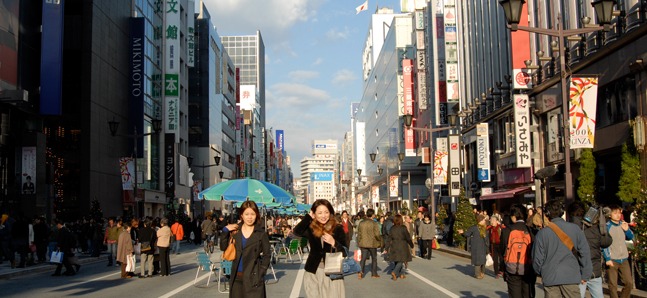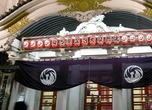
Posted: Tue Jul 21 2009
Times change but Ginza remains. A Zen koan? Hardly; it`s simply a fact of life in Tokyo. No matter how bleak the economic prospects appear, Tokyo-ites and tourists alike will still flock to the centre of Tokyo elegance. Other areas, notably Marunouchi and Aoyama, have raised their game in the last few years, but Ginza is still the steadfast bastion of sumptuous and pedigreed department stores, and the stage for international brands taking their first plunge in Japan. Likewise, Ginza is where you’ll find politicians and businessmen on bottomless expense accounts quaffing overpriced drinks in the company of kimono-clad bar staff. Less affluent Tokyoites simply come to dream.
As urbanisation revolutionised the capital during the 19th-century Meiji period, Ginza became the first part of Tokyo to be rebuilt in red brick rather than wood. Red brick was thought to offer greater protection from natural disasters, a theory disproved in 1923 when the area was razed by the Great Kanto Earthquake. Unfortunately, not one single red brick from Ginza’s first golden era survives today. However what does survive is a resilient, bustling and always elegant commercial and arts centre of the city.
The weekend ‘Ginbura’, or Ginza strolling is a time-tested Tokyo tradition; from noon at weekends cars are banned from the main street, Ginza Dori (also called Chuo Dori), creating what is known as hokousha tengoku (pedestrian heaven). Ginza`s wide streets host throngs of people swinging carrier bags with designer logos and cameras to snap photos of some of the most noted building projects of recent years.
Crammed into Ginza’s eight main blocks (chome) are over 10,000 shops, many of them selling goods at Bubble-era prices. Bolt-hole shops selling traditional items such as kimonos, wagashi (Japanese sweets) and go-boards sit side by side with brand giants such as Gucci and Cartier. Foreign retail chains tend to choose to have their first Japanese outlets in prestigious Ginza before opening up elsewhere.
- H&M
- One of the most recent editions is the Japanese flagship store of the pan-European mainstay. The shop, popular with Japanese shoppers and expats looking for styles and sizes from home, drew queues with three-hour waits months after its October 2008 opening.
- Address : 7-9-15 Ginza
- Telephone : (03)3571-8131
- URL : www.hm.com/jp
- United Arrows
- For a taste of home-grown chic, those living in Tokyo swear by the stylishly cohesive, less astronomically priced collections at this boutique chain.
- Address : 2-2-14 Ginza
- Telephone : (03)3562-7798
- URL:www.united-arrows.co.jp
- rtGinza
- With six storeys of goodies, Ragtag is a second-hand clothing shop that boasts a carefully cultivated and well-edited collection of designer label and couture clothing. Ginza’s fickle fashionistas keep the store stocked with barely worn garments from the latest catwalk collections.
- Address : 3-3-15 Ginza
- Telephone : (03)3535-4100
- Open : 11:00~20:00
- URL:www.ragtag.jp/cgi-bin/omc?req=misc/shop/ginza.html
The heated and flashy competition to attract Ginza shoppers has led the biggest names to commission stores with spectacular façades. Star architects have even made tourist attractions of stores for Mikimoto Ginza 2 (2-4-12 Ginza) by Toyo Ito, Maison Hermès (5-4-19 Ginza) designed by Renzo Piano, Louis Vuitton and Chanel, whose building boasts top French chef Alain Ducasse’s restaurant Beige Tokyo on the tenth floor. More recent and particularly spectacular architectural editions include the stunning Swarovski “Crystal Forest” (8-9-15 Ginza) by Tokujin Yoshioka, the minimal yet arresting showcase for Tiffany & Co. (2-7-17 Ginza) by Kengo Kuma, and the modern elegance of Doriana and Massimiliano Fuksas’ 12 storey Armani Ginza Tower (5-5-4 Ginza).
If you`re attracted to art on a smaller scale, Ginza hosts some of the more eminent galleries in Tokyo. Many of the designer buildings such as Maison Hermés, Chanel, and Armani Ginza Tower also house galleries. Aside from the more well-known spaces, such as Tokyo Art Gallery, INAX Gallery, and Wacoal Ginza Art Space, there are three standouts that represent a fresh take on Ginza's artistic side.
- Galleria Grafica Tokio
- Representing mostly contemporary artists, this gallery is a great way to see the best of Japan’s contemporary art scene. In addition to domestic artists, Galleria Grafica also exhibits art from international artists, and hosts a collection of prints from greats like Picasso, Klee, Kadinsky, Warhol, Hockney, Degas and others. The ground floor is a rental space, and not only showcases painting and prints, but also sculpture and installation art. Galleria Grafica is one of Tokyo`s heavy-hitters; it regularly participates in the legendary Art Basel festival.
- Address : Ginza S2 Building 1 2F, 6-13-4-Ginza
- Telephone : (03)5550-1335
- Open : 11am-7pm Mon-Sat
- Closed : Sun
- URL:www.galleriagrafica.com
- Shiseido Gallery
- After reopening in 2001, Shiseido Gallery, run by cosmetics giant Shiseido, is now one of the largest spaces for art in Ginza. Despite the name, it's more of a kunsthalle than a commercial gallery. It hosts important group and solo shows by contemporary Japanese and international artists such as Nakamura Masato and Roman Signer, plus occasional retrospectives and fashion-related shows. Even the building is a work of art, designed by Ricardo Bofill.
- Address : Tokyo Ginza Shiseido Building B1, 8-8-3 Ginza
- Telephone : (03)3572-3951
- Open : 11am-7pm Tue-Sat / 11am-6pm Sun
- Closed:Mon
- URL:www.shiseido.co.jp/e/gallery
- Vanilla Gallery
- Vanilla is a rare find in Tokyo. As one of the few erotic art galleries in the city, it holds a wide variety of exhibitions from artists of different stylistic sensibilities, from drawing and painting, to photography and multimedia.
- Address : 6-10-10 Ginza 4F,
- Telephone : (03)5568-1233
- Open : 12am-9pm Mon-Fri / 12pm-5pm Sat and Holidays
- Closed : Sun
- URL:www.vanilla-gallery.com
Shopping and art aren't the only draws in Ginza. Two of Tokyo's most famous locations are also in the area. As the city implements ongoing “improvements” to help increase tourism, and its bid for the 2016 Olympics, two landmarks will be forever changed in the near future.
- Kabuki-za theatre
- The home of kabuki . Reserved seats are pricey, but a single act of the day-long programme can be enjoyed for around ¥1,000. You’ll have to queue for tickets, and opera glasses are essential, but it’s a good way to get a taste of Japan’s traditional performing arts. Enjoy this legendary theatre while you can, performances will end in April 2010 and the building (opened in 1889) will be razed to make way for a newer one, a plan which has caused major controversy both in Japan and abroad.
- Address : 4-12-5 Ginza
- Telephone : (03)3541-3131
- URL:www.shochiku.co.jp/play/kabukiza/
- Tsukiji Fish Market
- The famous early morning wholesale seafood market is known for it’s wavering as much as the fish. After a short ban on visitors, which met with public disappointment, visitors are now allowed in once more. Then, the market was slated for relocation to Toyosu, however the poorly chosen site was not up to standard. Now a national issue, the relocation of the Tsukiji fish market has resulted in large scale cleanups at the new site, planned for use in 2014. In the meantime, harness your jet-lag or just your night out by heading over early. Though the tuna auction area is off-limits save an hour in the early morning, you can still see the mind-boggling variety of sea creatures on sale for consumption. Most of the business is over by midday, but take advantage of the location to have some sushi for breakfast; it’s the freshest and best in Tokyo.
Tags:
Tweets
- About Us |
- Work for Time Out |
- Send us info |
- Advertising |
- Mobile edition |
- Terms & Conditions |
- Privacy policy |
- Contact Us
Copyright © 2014 Time Out Tokyo











Add your comment